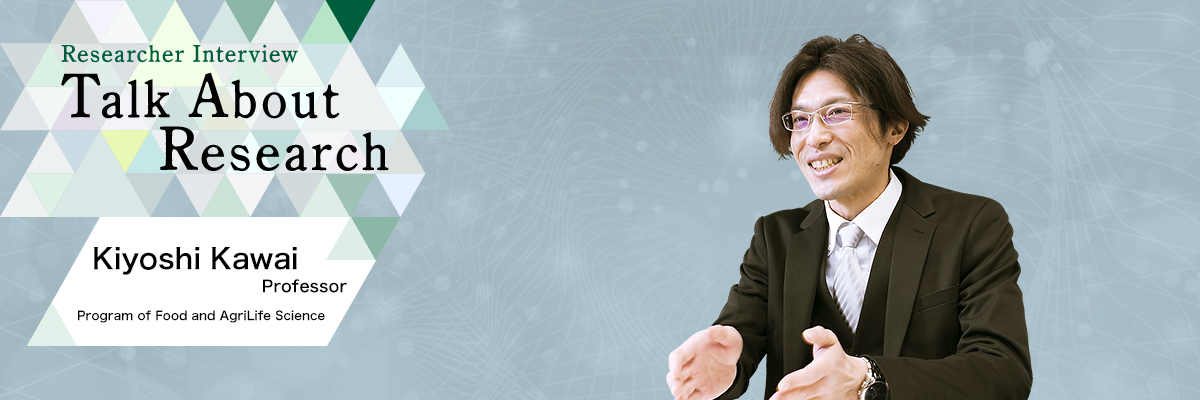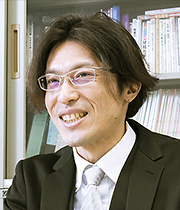Do we eat “glass”? …
Exploring the mysterious physical properties of foods and living organisms
Professor Kiyoshi Kawai leads a research group specializing in food engineering. This group carries out research to elucidate the physical properties of foods and food materials to apply the findings to the design of food product quality. The group’s research focuses on the characteristics of physical materials, with foods representing just one category thereof. When you look at foods as physical materials, you are bound to come across some surprises.
Prof. Kawai explains: “I think most people associate the word ‘glass’ with items like glasses that we drink from. But the word ‘glass’ actually refers to a state that all sorts of materials can take on, and so food can also be a ‘glass.’ In our research, we have confirmed that many starch-based dry foods, such as cookies, are in a glass state.”
That sounds as if we are eating glass, which is far from our conventional image of foods. And how is this related to food quality, by the way?
“The brittle texture of cookies is, in physical terms, the same sensation we would feel if glass were broken in our mouth. I’m sure you have experienced brittle cookies taking on a ductile texture after being exposed to humidity for a while. This occurs because cookies as a ‘hydrophilic glass’ absorb moisture and become rubbery. Haven’t you ever seen on TV or something how glass craftwork products are like starch syrup before they are cooled and hardened? That starch syrup-like state is a rubbery state. This phenomenon is called glass-rubber transition or simply glass transition, which is well known in the fields of industrial glass and synthetic polymer production. We have discovered that by applying the same principle to cookie making, it’s possible to quantitatively ‘design’ cookie texture and preservativeness. This means that we can make cookies that remain brittle in a moist atmosphere (maintaining a glass state at high humidity levels) and cookies that remain ductile in a dry atmosphere (maintaining a rubbery state at low humidity levels).”

Prof. Kawai continues, saying that such research leads to the finding of solutions to social problems related to the Sustainable Development Goals (SDGs):
“The principle of cookie texture also applies to fried foods. The batter-coated surface of freshly fried foods is vitrified, in a glass state, which provides a deliciously crispy texture. But as time passes, the coating becomes rubbery, and the texture turns soggy. When this happens, fried foods lose their commercial value. We hear that fried foods sold in convenience stores and other such places are thrown away after a certain period of time. This is because they have become less savory, not because they have gone bad. If we can keep fried foods crispy for a longer period, we can probably reduce food loss and waste.”
Prof. Kawai believes that all things are somewhat related to one another. In elucidating the mechanism of each phenomenon, which is made up of points of contact, you can find similar points of contact in the mechanisms of different phenomena. Such findings can lead to something completely new, such as new food products.
Prof. Kawai gives us an example: “By minutely regulating the glass transition of food materials, it’s now possible to mold powdery foods that cannot otherwise be solidified in stick form. Chocolate-dipped stick-shaped foods have been on the market for a long time, and there are even stick-shaped foods containing fruit powder. But wheat is indispensable for them as a binder. It’s now possible to make such foods 100% binder-free. With no extra additives, you can enjoy the genuine, undiluted taste and flavor of the ingredients. This is one example of how our research can expand the potential of food.”
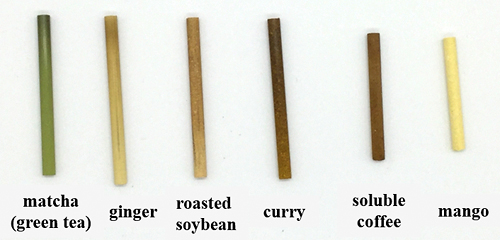
Points of contact between things are numerous. There are points of contact even between two seemingly unrelated phenomena. Prof. Kawai says he finds them by analogy. In this way, glass has led him to lactic acid bacteria.
He says: “Microorganisms can’t survive without water because they are living things after all. But in reality, many microorganisms have been found to survive dehydration. In fact, whether or not dehydration kills microorganisms seems to be closely related to vitrification. So, in addition to our basic research to elucidate the mechanism of vitrification with microorganisms, we are currently conducting applied research in collaboration with a food manufacturing company to figure out how to protect lactic acid bacteria with low levels of resistance to dehydration. This is because the consumption of lactic acid bacteria while they are alive is expected to increase health benefits for people.”
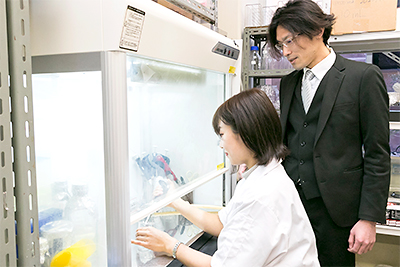
Diverse types of research exploring new possibilities of food
with original techniques and instruments
Far from solely focusing on vitrification, Prof. Kawai is involved in truly diverse types of research. For example…
“In our research with cookies, we also found that by slightly changing the way we bake them, we can make cookies less likely to raise the postprandial blood glucose level. Cookies are mainly made of wheat starch, and starch can be seen as a polymer material with crystalline parts. These crystalline parts become ‘liquid’ as they melt with heat during baking. Liquids are more chemically unstable than crystals, and so digestive enzymes become more active in a liquid state. We take advantage of this phenomenon and make cookies by sintering them to prevent them from melting (non-melting method). This way, plenty of crystalline starch remains in the cookies, raising the eater’s resistance to digestion and making it harder for the blood glucose level to rise.
“We are also working on the analysis and assessment of food texture. We describe delicious foods we enjoy with various words. For example, we say, ‘soft’ and ‘sticky’ regarding bread. But with several types of bread, it’s difficult to say which one is ‘softer’ or ‘stickier’ than the others, and to what degree. Yet, numerically expressing texture by objective parameters is essential if we want to quantitatively control and design food quality. We usually conduct this kind of research in collaboration with food companies.”
Prof. Kawai is thus pursuing research for various purposes, but he says that his research methodologies have not necessarily been well established from the beginning. According to him, this is also important for research:
“In our research, we can cover countless foods of widely differing types, depending on how the ingredients are combined, how they are processed, and how they are consumed. There is no single set of equipment that we can use for all of them. So we must start by designing our own instruments and methods for experiments and analysis. These steps also serve as a driving force for creative research results.”
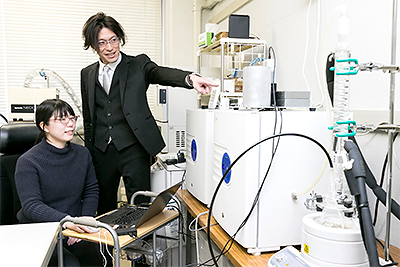

Three principles for research … and people are like food …
Prof. Kawai always keeps in mind three things when conducting his research: Analogy and the two dictums, “Discover the new by learning from the past” and “Everything is evanescent.”
“As I said earlier, I believe that all things are somehow connected with one another, and that you can create new value and make discoveries by finding an analogy between two things. The key is to think like the object you’re researching. This means that if it’s about bread, you must think of yourself as bread and imagine what it’s like!
“It’s also important to understand the wisdom of our predecessors and the efforts they have made. Food products are the fruits of past efforts that humanity has made over its long history in order to fight hunger and enrich lives. They have come into being inevitably, not accidentally. I think the shortcut to new value is appreciating the value of these past achievements and applying and adapting it to the present times (discovering the new by learning from the past).
“Finally, there is something I am always conscious of in my vision of life. Time. Food products usually come with an expiration date. Don’t you think it’s the same with people? But we shouldn’t consider this evanescence negatively or pessimistically. Just as we do with foods, we must try to enjoy ourselves within the limited time we’re given. That’s essential. We know from past research that the expiration date can be extended through our efforts. I’d love to continue to savor and enjoy research for a long time with like-minded students.”
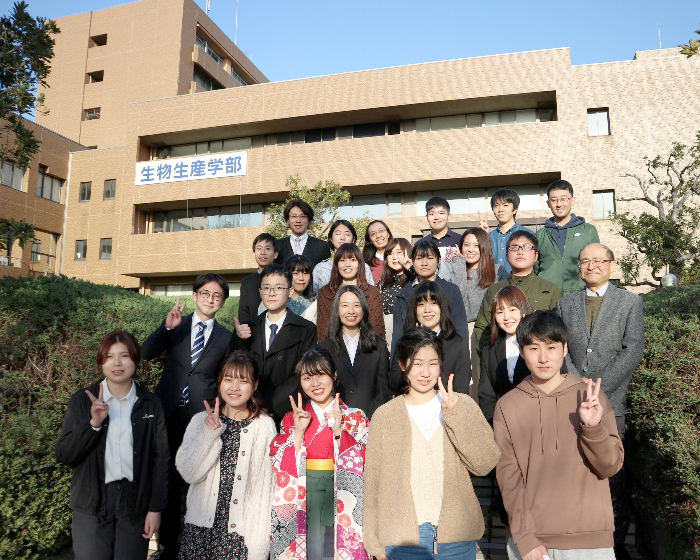 Food Physical Chemistry and Engineering
Food Physical Chemistry and Engineering(photographed with Prof. Hagura’s research group)
■Latest Information on the Program
Opened on November 4, 2021

